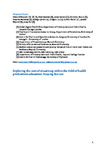Exploring the cost of eLearning within the field of health professions education: Scoping Review
| dc.contributor.author | Meinert, Edward | |
| dc.contributor.author | Reeves, S | |
| dc.contributor.author | Eerens, J | |
| dc.contributor.author | Banks, C | |
| dc.contributor.author | Maloney, S | |
| dc.contributor.author | Rivers, G | |
| dc.contributor.author | Ilic, D | |
| dc.contributor.author | Walsh, K | |
| dc.contributor.author | Majeez, A | |
| dc.contributor.author | Car, J | |
| dc.date.accessioned | 2020-12-19T11:43:40Z | |
| dc.date.issued | 2021-03 | |
| dc.identifier.issn | 2369-3762 | |
| dc.identifier.issn | 2369-3762 | |
| dc.identifier.other | e13681 | |
| dc.identifier.uri | http://hdl.handle.net/10026.1/16762 | |
| dc.description | No embargo required. | |
| dc.description.abstract |
Background: Existing research on the costs associated for design and deploying eLearning in health professions education is limited. The way in which these learning platforms compare in cost to face-to-face learning is also not well understood. The lack of pre-defined costing models used for eLearning cost data capture has made it difficult to complete cost evaluation. Objective: The key aim of this scoping review is to explore the state of evidence concerning cost capture within eLearning in health professions education. The review explores what data exists to define cost calculations related to eLearning. Methods: Scoping review using a search strategy of MeSH terms and related keywords centered on eLearning and cost calculation with a population scope of health professionals in all countries. The search was limited to English language studies. No restriction was placed on literature publication date. Results: In total, 7344 articles were returned from the original search of the literature. Of these, 232 were relevant to associated keywords or abstract references following screening. Full-text review resulted in 168 studies being excluded. Of these, sixty-one studies were excluded because they were unrelated to eLearning and focused on general education. One-hundred and three studies were excluded because of lack of detailed information regarding costs. These studies referred to cost in ways either indicating cost favorability or unfavorability, but without data to support findings. Finally, four studies were excluded because of limited cost data insufficient for analysis. In total, 42 studies provide data and analysis of the impact of cost and value in health professions education. The most common data source was total cost of training (n=29). Other sources included cost per learner; meaning the cost per individual student (n=13). The population most frequently cited was medical students (n=15), although a group of articles focused on multiple populations (n=12). A further 22 studies provide details of costing approaches for the production and delivery of eLearning. These studies provide insight into ways eLearning has been budgeted and project managed through implementation. Conclusions: While cost is a recognized factor in studies detailing eLearning design and implementation, the way cost is captured is done so inconsistently. Although there is a perception that eLearning is more cost-effective than face-to-face instruction, there is not yet sufficient evidence to assert this conclusively. A rigorous, repeatable data capture method is needed, in addition to a means to leverage existing economic evaluation methods that can then test whether eLearning cost-effectiveness and how to implement with cost benefits and advantages over traditional instruction. | |
| dc.format.extent | e13681-e13681 | |
| dc.format.medium | Electronic | |
| dc.language | en | |
| dc.language.iso | en | |
| dc.publisher | JMIR Publications | |
| dc.subject | costs and cost analysis | |
| dc.subject | distance education | |
| dc.subject | economics | |
| dc.subject | education | |
| dc.subject | online education | |
| dc.subject | online learning | |
| dc.subject | professional education | |
| dc.title | Exploring the cost of eLearning within the field of health professions education: Scoping Review | |
| dc.type | journal-article | |
| dc.type | Journal Article | |
| plymouth.author-url | https://www.ncbi.nlm.nih.gov/pubmed/33704073 | |
| plymouth.issue | 1 | |
| plymouth.volume | 7 | |
| plymouth.publication-status | Published online | |
| plymouth.journal | JMIR Medical Education | |
| dc.identifier.doi | 10.2196/13681 | |
| plymouth.organisational-group | /Plymouth | |
| plymouth.organisational-group | /Plymouth/Faculty of Health | |
| plymouth.organisational-group | /Plymouth/Faculty of Health/School of Nursing and Midwifery | |
| plymouth.organisational-group | /Plymouth/REF 2021 Researchers by UoA | |
| plymouth.organisational-group | /Plymouth/REF 2021 Researchers by UoA/UoA03 Allied Health Professions, Dentistry, Nursing and Pharmacy | |
| plymouth.organisational-group | /Plymouth/Users by role | |
| plymouth.organisational-group | /Plymouth/Users by role/Academics | |
| plymouth.organisational-group | /Plymouth/Users by role/Researchers in ResearchFish submission | |
| dc.publisher.place | Canada | |
| dcterms.dateAccepted | 2020-12-18 | |
| dc.rights.embargodate | 2020-12-25 | |
| dc.identifier.eissn | 2369-3762 | |
| dc.rights.embargoperiod | Not known | |
| rioxxterms.versionofrecord | 10.2196/13681 | |
| rioxxterms.licenseref.uri | http://www.rioxx.net/licenses/all-rights-reserved | |
| rioxxterms.licenseref.startdate | 2021-03 | |
| rioxxterms.type | Journal Article/Review |


